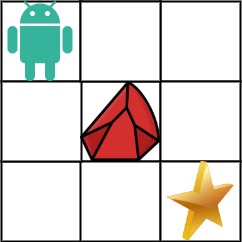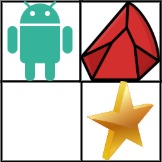Unique Paths II - Top down and bottom up DP
Problem Statement:
You are given an m x n integer array grid. There is a robot initially located at the top-left corner (i.e., grid[0][0]). The robot tries to move to the bottom-right corner (i.e., grid[m - 1][n - 1]). The robot can only move either down or right at any point in time.
An obstacle and space are marked as 1 or 0 respectively in grid. A path that the robot takes cannot include any square that is an obstacle.
Return the number of possible unique paths that the robot can take to reach the bottom-right corner.
The testcases are generated so that the answer will be less than or equal to 2 * 109.
Example 1:

Input: obstacleGrid = [[0,0,0],[0,1,0],[0,0,0]] Output: 2 Explanation: There is one obstacle in the middle of the 3x3 grid above. There are two ways to reach the bottom-right corner: 1. Right -> Right -> Down -> Down 2. Down -> Down -> Right -> Right
Example 2:

Input: obstacleGrid = [[0,1],[0,0]] Output: 1
Constraints:
m == obstacleGrid.lengthn == obstacleGrid[i].length1 <= m, n <= 100obstacleGrid[i][j]is0or1.
Solution:
The basic logic that we would like to implement is the following (in pseudocode):
fun(i,j)
if (i,j) is bottom-right corner return 1
if i,j has obstacle return 0
return fun(i+1,j) + fun(i,j+1)
Our final answer by this logic is fun(0,0). We can implement this logic in top down or bottom up fashion.
Top down solution:
class Solution {
vector<vector<int>> memo;
public:
int util(int i, int j, int m, int n, vector<vector<int>>&grid)
{
if (i==m-1 && j==n-1) return 1;
if (i==m || j==n || grid[i][j]) return -1;
if (memo[i][j]!=-1) return memo[i][j];
int res = 0;
int a = util(i+1, j, m, n, grid);
int b = util(i, j+1, m, n, grid);
if (a!=-1) res += a;
if (b!=-1) res += b;
return memo[i][j] = res;
}
int uniquePathsWithObstacles(vector<vector<int>>& obstacleGrid)
{
int m=obstacleGrid.size(), n=obstacleGrid[0].size();
if (obstacleGrid[0][0] || obstacleGrid[m-1][n-1]) return 0;
memo = vector<vector<int>>(m, vector<int>(n,-1));
return util(0,0,m,n,obstacleGrid);
}
};
Bottom-up solution:
class Solution {
public:
int uniquePathsWithObstacles(vector<vector<int>>& obstacleGrid)
{
int m=obstacleGrid.size(), n=obstacleGrid[0].size();
if (obstacleGrid[0][0] || obstacleGrid[m-1][n-1]) return 0;
vector<vector<int>> res(m, vector<int>(n,0));
int r=0,c=0;
while(r<m && obstacleGrid[r][0]==0) {res[r][0]=1; r++;}
while(c<n && obstacleGrid[0][c]==0) {res[0][c]=1; c++;}
for(int i=r; i<m; i++) res[i][0]=0;
for(int j=c; j<n; j++) res[0][j]=0;
for(int i=1; i<m; i++)
{
for(int j=1; j<n; j++)
{
if (obstacleGrid[i][j]){res[i][j]=0; continue;}
res[i][j] = res[i-1][j]+res[i][j-1];
}
}
return res[m-1][n-1];
}
};
Bottom-up solution with $O(1)$ memory:
class Solution {
public:
int uniquePathsWithObstacles(vector<vector<int>>& grid)
{
int m=grid.size(), n=grid[0].size();
if (grid[0][0] || grid[m-1][n-1]) return 0;
int r=0,c=1;
while(r<m && grid[r][0]==0) {grid[r][0]=1; r++;}
while(c<n && grid[0][c]==0) {grid[0][c]=1; c++;}
for(int i=r; i<m; i++) grid[i][0]=0;
for(int j=c; j<n; j++) grid[0][j]=0;
for(int i=1; i<m; i++)
{
for(int j=1; j<n; j++)
{
if (grid[i][j]){grid[i][j]=0; continue;}
grid[i][j] = grid[i-1][j]+grid[i][j-1];
}
}
return grid[m-1][n-1];
}
};
TC: $O(mn)$ for all solutions.